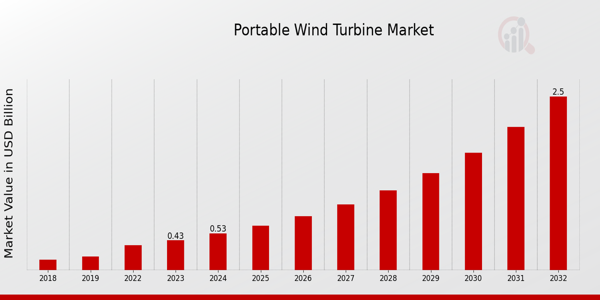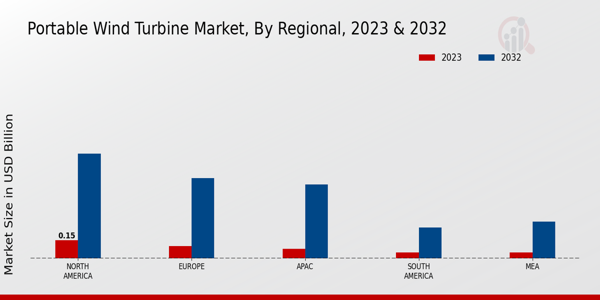Global Portable Wind Turbine Market Overview
As per MRFR analysis, the Portable Wind Turbine Market Size was estimated at 0.64 (USD Billion) in 2024. The Portable Wind Turbine Market Industry is expected to grow from 0.78 (USD Billion) in 2025 to 4.50 (USD Billion) till 2034, at a CAGR (growth rate) is expected to be around 21.44% during the forecast period (2025 - 2034).
Key Portable Wind Turbine Market Trends Highlighted
The Portable Wind Turbine Market is experiencing significant growth driven by rising energy demands and the urgent need for sustainable energy solutions. The increasing focus on renewable energy sources, along with government incentives for clean energy, is propelling market expansion. Additionally, advancements in technology have made portable wind turbines more efficient and cost-effective for both personal and commercial use. Concerns about climate change and energy independence further fuel interest in portable wind turbines as an eco-friendly alternative for energy generation. Opportunities in the market are plentiful, particularly with the growing trend of off-grid energy solutions.Portable wind turbines can be particularly useful in remote areas, disaster relief situations, and for outdoor activities like camping. The ability to harness wind energy in various locations appeals to consumers and businesses looking for flexible energy solutions. As awareness of renewable energy options increases, there is a potential for innovative designs and expanded product offerings, which could cater to a broader demographic. Recent trends indicate a rise in consumer interest toward energy-efficient appliances and devices, including portable wind turbines. There is a growing acceptance of renewable energy technologies in everyday life, promoting further investment and development in this sector.Additionally, collaborations between technology developers and renewable energy companies are becoming common as the industry seeks to enhance product performance and reliability. The market is on the brink of innovation, making it an exciting area for both new and existing players looking to capitalize on the surge in eco-conscious consumer behavior.

Source: Primary Research, Secondary Research, MRFR Database and Analyst Review
Portable Wind Turbine Market Drivers
Growing Demand for Renewable Energy Solutions
The increasing global emphasis on sustainable and renewable energy sources is driving the growth of the Portable Wind Turbine Market Industry. With the growing concerns about climate change and environmental degradation, governments and enterprises worldwide are seeking effective methods to transition from fossil fuels to renewable sources of energy. Portable wind turbines present a viable solution for generating clean energy, especially in remote and off-grid locations.These wind turbines can be utilized in various applications, including residential use, emergency power supply, and military operations, which enhances their appeal. As awareness increases regarding the environmental benefits of wind energy, demand for portable wind turbines is expected to rise significantly. The potential for reduced carbon footprints and lower electricity costs make portable wind turbines an attractive option for individuals and organizations looking to invest in green energy technologies.With substantial investments poured into the development of innovative technologies and infrastructure surrounding renewable energy, the Portable Wind Turbine Market is poised for significant growth over the coming years.
Advancements in Technology
Technological advancements in wind energy solutions are significantly enhancing the efficiency and usability of portable wind turbines. Innovations in turbine design, materials, and energy storage systems are making these turbines more effective and easier to deploy in various environments. The Portable Wind Turbine Market Industry is witnessing the introduction of lightweight, compact designs that improve mobility and installation, thus attracting a broader customer base.Increased efficiency translates to better energy output, making portable turbines a more attractive option for consumers. As technology continues to evolve, the capabilities and performance of portable wind turbines are expected to improve, leading to further market expansion.
Increasing Application Scope
The versatility of portable wind turbines is expanding their application range, thereby driving the market's growth. These devices can be utilized in a variety of settings, including camping, outdoor activities, remote work locations, and disaster relief operations. The Portable Wind Turbine Market Industry is adapting to meet the needs of various sectors, including telecommunications, agriculture, and military. This growing range of applications attracts a diverse customer base, from individual consumers to large organizations.The ability to provide reliable power in remote or off-grid areas enhances the appeal of portable wind turbines, encouraging more users to consider them as feasible energy solutions. As more applications for portable wind turbines continue to emerge, the market is expected to flourish.
Portable Wind Turbine Market Segment Insights
Portable Wind Turbine Market Application Insights
The Application segment within the Portable Wind Turbine Market plays a crucial role in the overall market dynamics, reflecting a diverse range of use cases that contribute significantly to its growth. In 2023, the Portable Wind Turbine Market revenue was valued at 0.43 USD Billion, showcasing a robust interest in renewable energy solutions. By 2032, this value is projected to increase to 2.5 USD Billion, indicating a steady upward trajectory in the market growth. Among the various applications, Remote Power Generation holds a prominent position with a valuation of 0.1 USD Billion in 2023 and anticipated growth to 0.57 USD Billion by 2032. This segment is essential for providing energy to off-grid areas, which often lack access to conventional power sources, thus supporting sustainable development in remote locations.
Telecommunications emerges as another significant player within the Application segment, valued at 0.07 USD Billion in 2023, with projections reaching 0.39 USD Billion in 2032. The importance of portable wind turbines in this sector is highlighted by their ability to ensure uninterrupted power supply for communication towers, particularly in areas where grid access is unreliable or unavailable. The Military Use segment, with a value of 0.08 USD Billion in 2023, also signifies its necessity, growing to 0.46 USD Billion by 2032. Portable wind turbines provide essential energy solutions for military operations in remote locations, enhancing energy independence and reducing reliance on fuel transportation.
The Emergency Backup Power segment, valued at 0.09 USD Billion in 2023 and expected to grow to 0.51 USD Billion by 2032, showcases its critical role in resiliency planning across industries, ensuring that businesses and communities can maintain operations during power outages or disasters. Finally, the Residential application, also at 0.09 USD Billion in 2023, is projected to increase to 0.57 USD Billion by 2032. This highlights a growing trend among homeowners adopting sustainable energy solutions that align with environmental goals and reduce utility costs. The Portable Wind Turbine Market statistics indicate a diverse landscape where each application area holds unique significance, catering to specific energy needs and contributing to a broader commitment toward renewable energy adoption.
The overall market segmentation illustrates a clear pattern of growth across all applications, fueled by a shift toward sustainable energy solutions, technological advancements in wind turbine design, and increasing environmental awareness. The market data reflects an increasing acceptance and integration of portable wind turbines into everyday life, reinforcing their potential to address modern energy challenges effectively. The opportunities and challenges within this segment reveal a dynamic interplay of factors influencing growth, including government policies supporting renewable energy, infrastructure development in remote areas, and the ongoing need for reliable and resilient energy sources across various sectors.

Source: Primary Research, Secondary Research, MRFR Database and Analyst Review
Portable Wind Turbine Market Technology Insights
The Portable Wind Turbine Market is experiencing significant growth within the Technology segment, primarily driven by the rising demand for sustainable energy solutions and advancements in turbine design. In 2023, the market valuation stands at 0.43 billion USD, reflecting a healthy interest in portable wind energy solutions. Among the various technologies, Horizontal Axis Wind Turbines are well-established, often recognized for their efficiency and dominance in energy production, making them a preferred choice in many applications. Vertical Axis Wind Turbines, on the other hand, are gaining traction due to their unique design, which allows for energy generation in turbulent wind conditions, thus providing versatility across different environments.Additionally, Micro Wind Turbines are becoming increasingly significant in urban areas and remote locations where space is a constraint, offering a practical solution for small-scale energy needs. Overall, the Portable Wind Turbine Market segmentation highlights a diverse arena ripe for innovation, with each technology offering unique advantages and addressing specific market demands, contributing to the overall market growth and future expansion plans.
Portable Wind Turbine Market End Use Insights
The Portable Wind Turbine Market, valued at 0.43 billion USD in 2023, showcases significant growth potential across various end-use applications. The market is witnessing increased adoption driven by environmental concerns and the need for sustainable energy solutions. Each end-use category plays a pivotal role; for instance, the commercial sector is capitalizing on renewable energy integration, while the industrial segment emphasizes energy independence and reduced operational costs. Residential applications are becoming increasingly popular as more homeowners seek reliable, off-grid power sources.Military usage of portable wind turbines reflects the necessity for energy security in remote locations, highlighting the growing demand for innovative solutions in challenging environments. As the Portable Wind Turbine Market revenue grows, fluctuating energy costs and government incentives further propel these segments. Overall, the market growth trajectory presents numerous opportunities, yet challenges such as supply chain disruptions and technological advancements are pivotal for stakeholders to navigate. The segmentation provides valuable insights into market dynamics and influences strategic decisions in this evolving industry, fueling the expansion of the Portable Wind Turbine Market statistics and data.
Portable Wind Turbine Market Component Insights
The Portable Wind Turbine Market revenue in 2023 is valued at 0.43 billion USD, showcasing a promising pathway for growth, particularly within the Component segment. This segment encompasses critical elements such as Blades, Generators, Control Systems, Towers, and Battery Storage, each playing a pivotal role in enhancing operational efficiency and performance of portable wind turbines. Blades serve as the primary driver for energy capture, while efficient Generators convert wind energy into usable electricity, underscoring their significant contributions.Control Systems are vital for optimizing performance and ensuring safety, leading to a well-functioning turbine system. Towers provide structural support and elevate turbine mechanisms to access stronger winds, while Battery Storage is crucial for energy management and ensuring a consistent power supply when wind availability fluctuates. Growing awareness and increasing adoption of renewable energy solutions further amplify the importance of Balancing these components to drive market opportunities. The Portable Wind Turbine Market statistics indicate that as the demand for sustainable energy grows, innovations within these individual components are expected to fuel market growth significantly from 2024 to 2032.
Portable Wind Turbine Market Regional Insights
The Portable Wind Turbine Market demonstrates a robust regional segmentation, with total revenues reflecting a significant growth potential. North America holds a majority share, valuing 0.15 USD Billion in 2023 and reaching 0.85 USD Billion by 2032, showcasing its dominance in the market. Europe follows, valued at 0.1 USD Billion in 2023 and expected to rise to 0.65 USD Billion, indicating its pivotal role in adopting renewable energy technologies. The APAC region, with a valuation of 0.08 USD Billion in 2023, is projected to grow to 0.6 USD Billion, signaling considerable interest in sustainable energy solutions.South America and the MEA regions, although smaller players with both valued at 0.05 USD Billion in 2023, are anticipated to experience growth as renewable energy initiatives gain traction, reaching valuations of 0.25 USD Billion and 0.3 USD Billion, respectively, by 2032. This market segmentation reflects varying adoption rates and energy policies across regions, highlighting North America's leadership and Europe's commitment to advancing green technology, while APAC's emerging market potential indicates growing opportunities in the Portable Wind Turbine Market revenue landscape.The market trends will continue to be driven by increasing demand for clean energy solutions, contributing to the ongoing transformation of the Portable Wind Turbine Market industry.

Source: Primary Research, Secondary Research, MRFR Database and Analyst Review
Portable Wind Turbine Market Key Players and Competitive Insights
The Portable Wind Turbine Market has seen significant growth and innovation in recent years, driven by increasing demand for renewable energy solutions and a shift towards sustainable living. Competition in this market is characterized by a blend of established players and emerging startups, each vying to capture market share through technological advancements, product differentiation, and strategic partnerships. Companies within this space are exploring various applications for portable wind turbines, including off-grid energy generation for remote locations, disaster recovery efforts, and providing clean energy during outdoor events. This evolving landscape highlights the drive towards efficiency and adaptability in the technologies deployed, influencing pricing strategies and the overall market dynamics.Windstream Technologies stands out in the Portable Wind Turbine Market due to its pioneering approach to wind energy solutions. The company has developed innovative turbine designs that cater to diverse applications, effectively addressing customer needs for both residential and commercial energy solutions. One of the key strengths of Windstream Technologies is its commitment to sustainability and energy efficiency, emphasizing the importance of reducing carbon footprints and promoting renewable sources. The company’s strategic focus on research and development enables it to stay ahead in technological advancements, allowing for products that offer higher energy output and reduced maintenance costs. Furthermore, Windstream Technologies’ strong brand presence and customer-centric approaches contribute to its competitive advantage, solidifying its position as a leader in the portable wind turbine segment.Avent Technologies is another notable player in the Portable Wind Turbine Market, recognized for its innovative and practical solutions. The company focuses on developing portable wind turbines that emphasize ease of use and efficiency, making them ideal for various applications such as camping, telecommunications, and temporary power generation at remote sites. One of the merits of Avent Technologies is its ability to integrate cutting-edge technology with user-friendly designs, resulting in products that are not only effective but also accessible to a wider range of consumers. Additionally, Avent Technologies emphasizes collaboration with industry partners to enhance its product offerings and market reach, thereby strengthening its competitive position. The company’s dedication to advancing portable wind energy solutions has established it as a formidable contender within the market, appealing to environmentally-conscious consumers seeking reliable renewable energy sources.
Key Companies in the Portable Wind Turbine Market Include
- Windstream Technologies
- Avent Technologies
- Enercon
- Senvion
- Siemens Gamesa
- United Renewable Energy
- GE Renewable Energy
- Vestas Wind Systems
- Honeywell
- Nordex Acciona
- SolarWind
- Clyde Bergemann Power Group
- Nordex
- Eocycle Technologies
- Suzlon Energy
Portable Wind Turbine Market Industry Developments
The Portable Wind Turbine Market has seen significant developments recently, driven by increasing demand for sustainable energy solutions. Companies like Siemens Gamesa and GE Renewable Energy are at the forefront, focusing on innovations that enhance efficiency and portability. Windstream Technologies has introduced advanced designs aimed at improving energy capture in diverse environments, while Vestas Wind Systems continues to expand its market share by optimizing its portable offerings. On the current affairs front, there is a notable rise in investments in portable wind technologies, with major players like Enercon and Senvion actively pursuing new projects to capitalize on the growing eco-conscious consumer base.
Furthermore, merger and acquisition activities are becoming more prevalent, with notable moves involving companies such as Nordex and Eocycle Technologies, aiming to strengthen their positions in this competitive market. The valuation of these companies is rising, reflecting a robust growth trajectory that indicates a positive outlook for the portable wind turbine segment. This growth is also fostering enhanced competition, pushing companies to innovate continuously and provide more efficient solutions to meet the global energy demands.
Portable Wind Turbine Market Segmentation Insights
- Portable Wind Turbine Market Application Outlook
- Remote Power Generation
- Telecommunications
- Military Use
- Emergency Backup Power
- Residential
- Portable Wind Turbine Market Technology Outlook
- Horizontal Axis Wind Turbines
- Vertical Axis Wind Turbines
- Micro Wind Turbines
- Portable Wind Turbine Market End Use Outlook
- Commercial
- Industrial
- Residential
- Military
- Portable Wind Turbine Market Component Outlook
- Blades
- Generators
- Control Systems
- Tower
- Battery Storage
- Portable Wind Turbine Market Regional Outlook
- North America
- Europe
- South America
- Asia Pacific
- Middle East and Africa
| Report Attribute/Metric |
Details |
|
Market Size 2024
|
0.64 (USD Billion)
|
|
Market Size 2025
|
0.78 (USD Billion)
|
|
Market Size 2034
|
4.50 (USD Billion)
|
|
Compound Annual Growth Rate (CAGR)
|
21.44% (2025 - 2034)
|
|
Report Coverage
|
Revenue Forecast, Competitive Landscape, Growth Factors, and Trends
|
|
Base Year
|
2024
|
|
Market Forecast Period
|
2025 - 2034
|
|
Historical Data
|
2019 - 2023
|
| Market Forecast Units |
USD Billion |
| Key Companies Profiled |
Windstream Technologies, Avent Technologies, Enercon, Senvion, Siemens Gamesa, United Renewable Energy, GE Renewable Energy, Vestas Wind Systems, Honeywell, Nordex Acciona, SolarWind, Clyde Bergemann Power Group, Nordex, Eocycle Technologies, Suzlon Energy |
| Segments Covered |
Application, Technology, End Use, Component, Regional |
| Key Market Opportunities |
Rising demand for renewable energy, Increasing adoption in remote locations, Technological advancements in efficiency, Growing focus on sustainable tourism, Government incentives for clean energy |
| Key Market Dynamics |
Rising renewable energy demand, Technological advancements in design, Increasing off-grid applications, Government incentives for renewables, Growing environmental awareness |
| Countries Covered |
North America, Europe, APAC, South America, MEA |
Frequently Asked Questions (FAQ) :
The Portable Wind Turbine Market is expected to be valued at 4.50 billion USD by 2034.
The Portable Wind Turbine Market is projected to have a CAGR of 21.44% from 2025 to 2034.
North America is expected to have the highest market value of 0.85 billion USD by 2032.
The Remote Power Generation application is projected to be valued at 0.57 billion USD by 2032.
Key players include Windstream Technologies, Siemens Gamesa, and GE Renewable Energy among others.
The Military Use segment is anticipated to reach a market value of 0.46 billion USD by 2032.
The Emergency Backup Power segment is expected to be valued at 0.51 billion USD by 2032.
The European market is forecasted to grow to 0.65 billion USD by 2032.
The Telecommunications application is estimated to reach 0.39 billion USD by 2032.
The APAC region is projected to grow to a market size of 0.6 billion USD by 2032.





























